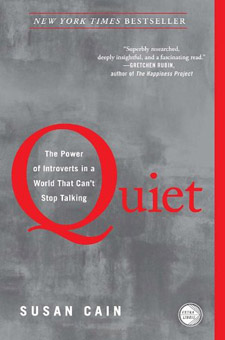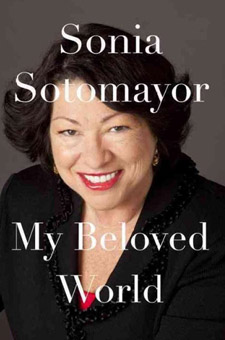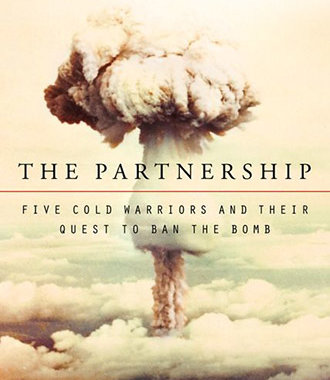Introverts need less outside stimulation than extroverts. They shut the door while extroverts keep it open. Introverts work slowly and deliberately, whereas extroverts work quickly and multitask. Introverts’ nervous systems can go into “overdrive” when they “enter a room full of people.” They would rather be home with family, or have a one-on-one with a close friend. Extroverts—charged up and ready to go—are the life of the party. Their nervous systems are geared toward pleasure and excitement. Introverts comprise anywhere between one third to one half of Americans, depending upon the study cited. Given such a high number of introverts in our extroverted society, you know more introverts than you might think: a teacher, your pastor, an uncle, your accountant, a doctor—any one of which could be posing as an extrovert.
Over the previous seven “blissful” years, author Susan Cain investigated the subject of “introversion,” compelled by her need to understand herself better and to get control of her fear of public speaking—after practicing corporate law and representing clients such as JP Morgan and General Electric and training hedge fund managers as a negotiations consultant. The end result of her investigation is the book she published in January 2012: Quiet: The Power of Introverts in a World That Can’t Stop Talking. It has been a major hit, reaching the non-fiction best-seller list and initiating a national conversation about introversion and extroversion.
As soon as Quiet was published, Cain appeared on various media outlets and gave numerous radio interviews. In February, she “took the stage at the 2012 TED Talks before an audience of 1,500 people to critique a society that favors the kind of person who craves an audience.” Her reward? A standing ovation and 2,196,888 views on TED since it was posted in March. These startling results belie the notion that Cain, a true introvert, overcame her need for quiet, autonomy, and solitude to become an extrovert overnight. Her passion for her “core personal project”— to promote the power of introversion in a garrulous world—forced her into performance mode. She became a “Public Introvert.”
Posing as an extrovert was not an easy task for Cain. She tells of how she had to prepare for a year before the publication of Quiet and, specifically, for the TED talk. She joined Toastmasters to practice public speaking; then she took a “two-hour crash course with TED’s speaking coach.” Still, that was not enough. Her practice performances projected her introversion as nervous energy and mediocrity. Panicked, she hired an acting coach a week before the talk, practicing first on a sofa, then onstage in front of other like-minded introverts. She wondered how she was going to get through the performance “without falling down or throwing up.” She says she doesn’t remember a thing about the talk, but by stretching herself beyond her temperament, she felt liberated—“though wildly incongruous”—as she “metamorphosed” into “the Public Introvert.” Her passion for promoting the values of introversion, as she lays out in Quiet, has its own demands: She must “make a little noise.”
The values of introversion Cain promotes in Quiet are most likely known to people who align their behavior with the temperamental traits of an introvert, perhaps after a lifelong struggle in a world that boasts of the “Extrovert Ideal.” As defined by Cain, the ideal extrovert “self is gregarious, alpha, and comfortable in the spotlight. The archetypal extrovert prefers action to contemplation, risk-taking to heed-taking, certainty to doubt. He favors quick decisions, even at the risk of being wrong. She works well in teams and socializes in groups.” It is the rare introvert who can become an extrovert (as extrovert is described above), or stretch herself toward the far end of the extroverted side of the spectrum. Indeed, it is probably impossible.
“Temperament,” as Cain explains, “refers to inborn, biologically-based behavioral and emotional patterns that are observable in infancy and early childhood; personality is the complex brew that emerges after cultural influence and personal experience are thrown into the mix”—temperament is the foundation, personality the building. “According to the theory of gene-environment interaction, people who inherit certain traits tend to seek out life experiences that reinforce those characteristics.” For example, “the most low-reactive kids…court danger from the time they’re toddlers,” whereas high-reactive kids “spend time inside the familiar—and intellectually fertile—environment of their own heads.” In fact, in a study in which fMRIs (functional magnetic resonance imaging) were done on adults who had been part of a research project as infants, scientists found that “the footprint of a high- or low-reactive temperament never disappeared in adulthood.”
And, yet, things are never so cut and dry, as Cain discovers in her quest to understand the introversion-extroversion spectrum. Environment plays a huge role in the “wide range of possible outcomes for each temperament,” and “free will” can subvert what is “ordained by our genes, our brains, by our nervous system.” However, “it cannot carry us infinitely beyond our genetic limits.” The introvert has to push herself to give a speech, go to a rollicking party, engage with strangers, or enjoy the novelty of traveling to far-off places. The extrovert, on the other hand, would not choose to curl up with a book in front of the fireplace if there’s a party going on in his next-door neighbor’s apartment. Cain herself has learned how to stretch her inherent temperament to move beyond her comfort zone. How else can she tell the world about the individual and cultural value of introversion, without stepping into the limelight to passionately advocate for this “second-class personality trait”?
If you are an American looking at your country from an introverted point of view, you will agree with Cain that it is biased “toward action” rather than intellect; that Americans have a “cultural preference for extroversion.” You will probably also agree with her view that in today’s world people, especially teens, are consumed with their “status, income, and self-esteem,” and “depend more than ever on the ability to meet the demands of the Culture of Personality.” In other words, creating a “good personality”—charming, charismatic, conversational— goes a long way to becoming a successful person.
Think of it in this way: How to Win Friends and Influence People by Dale Carnegie was first published in 1936, but it continues to be a best-selling book, not only here in the United States but around the world. And if this isn’t enough to convince someone that the “extroverted ideal” isn’t “an oppressive standard to which most of us feel we must conform,” consider Cain’s critique of the recent trend toward cooperative or group learning classrooms that appeal to the extroverted temperament but “deprive schoolchildren of the skills they’ll need to achieve excellence in an increasingly competitive world”; or open-plan offices that “reduce productivity and impair memory,” and have been found to make workers “sick, hostile, unmotivated and insecure.”
Cain suggests we rethink open-plan offices and classroom pods to help the struggling introvert work and learn in an extroverted environment. For example, flexible open plans could “offer a mix of solo workspaces, quiet zones, casual meeting areas, cafes, reading rooms, computer hubs…” for the introvert who can’t take the noise of an open office. A similar reconfiguration could also happen in schools. Introverts don’t need to be cured of their introversion; they just need classrooms that appeal to their temperament: small, quiet ones in which groups are carefully managed and where they can work independently. Who knows? The next Stephen Wozniak, the co-founder of Apple, could be sitting today in a quiet classroom.
Thanks to Cain’s exposing her own struggle with introversion and making more than a little noise in defense of introverts, the country is having an intelligent discussion that illuminates the worth of an introvert in a decidedly extroverted society. Recent studies have shown that highly sensitive introverts “tend to be keen observers who look before they leap.” They seem to be more philosophically or spiritually oriented and describe themselves “as creative or intuitive.” Small talk bores them, perhaps because they “think in an unusually complex fashion.” They feel their emotions deeply—joy, sorrow, fear gets to them. Their increased sensitivity to their physical and emotional environment can also make life more difficult for them, but it also has an up side: They tend to have strong consciences.
Take Eleanor Roosevelt, for example, who, as “a shy young woman,” was “terrified of public speaking” but “grew to love public life.” During the Great Depression, she traveled the country and listened “to ordinary people tell their hard-luck stories.” She became for her husband, President Franklin Roosevelt, “the voice of the dispossessed” and “pressed him to act.” Highly sensitive and thin-skinned, Eleanor Roosevelt became the conscience of the world when she helped “win passage of the Universal Declaration of Human Rights” as a United States delegate to the United Nations in 1948.
Like Eleanor Roosevelt, there are hundreds—thousands—of introverted women and men who, because of their intense feeling, inner-directedness, complex thinking, and committed passion, have introduced new ways of thinking and being. In the fields of science, the humanities, technology, or public service, introverts have substantially influenced the trajectory of culture and civilization. Here is a short list of some of these introverts: Albert Einstein, Vincent van Gogh, Marie Curie, Mother Teresa, Carl Jung, Abraham Lincoln, Frederic Chopin, Paul Gaugin, Barbara Bush, Michael Jordan, Liberace, Oprah Winfrey, Susan B. Anthony, Albert Schweitzer, Virginia Woolf, Dwight D. Eisenhower, Jackie Onassis, Jackie Joyner-Kersee, Queen Elizabeth II, Steven Spielberg, Jane Goodall, Warren Buffett, Ellen DeGeneres, J.K. Rowling, Larry Page, Stephen Hawking, Charles Darwin, Caesar Chavez, Princess Diana, Nelson Mandela, Mahatma Gandhi, and Rosa Parks.
Not every introvert will be among the talented and famous few, but they can give back in their own way, “to their families, societies, and ultimately themselves….” The best thing they can do is to be themselves, listen to the quiet, and not be afraid of the extroversion around them. Cain gives this piece of advice at the end of Quiet: “Whoever you are, bear in mind that appearance is not reality. Some people act like extroverts, but the effort costs them in energy, authenticity, and even physical health. Others seem aloof or self-contained, but their inner landscapes are rich and full of drama. So the next time you see a person with a composed face and a soft voice, remember that inside her mind she might be solving an equation, composing a sonnet, designing a hat. She might, that is, be deploying the power of quiet.”




1 comment
I bought this book after reading this review. I find inspiration in the last line that introverts deploy the power of quiet. I can’t wait to read it all.